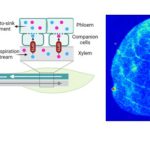Plant Science Research Weekly: July 21, 2023
Focus Issue: Biomolecular Condensates
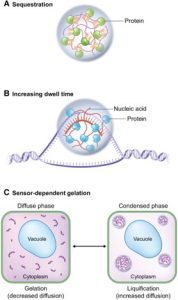 Although The Plant Cell Focus Issue on Biomolecular Condensates officially comes out in September, due to the idiosyncrasies of publishing many of the articles are already available online, and I’m highlighting them now because this topic is also the focus of a plenary session at the Plant Biology meeting in August (https://plantbiology.aspb.org/plenaries/). Although the term “biomolecular condensates” is relatively new, it actually reflects a convergence and synthesis of several distinct threads of research. Biomolecular condensates span from “classic” membraneless organelles (e.g., nucleolus, pyrenoid) to small, transient functional condensates, some of which are only recently recognized. I particularly enjoyed reading about how membranes can be involved in the formation of some of these condensates, revealing yet again that cells are stunningly sophisticated systems. A lot of the advancements in our understanding come from new tools and imaging techniques that reveal condensate structures and functions, many of which are reviewed here. The collection provides a great overview of this coalescing discipline, and it’s one not to miss. Start with the editorial overview by Gutierrez-Beltran et al. (Summary by Mary Williams @PlantTeaching) Plant Cell 10.1093/plcell/koad182
Although The Plant Cell Focus Issue on Biomolecular Condensates officially comes out in September, due to the idiosyncrasies of publishing many of the articles are already available online, and I’m highlighting them now because this topic is also the focus of a plenary session at the Plant Biology meeting in August (https://plantbiology.aspb.org/plenaries/). Although the term “biomolecular condensates” is relatively new, it actually reflects a convergence and synthesis of several distinct threads of research. Biomolecular condensates span from “classic” membraneless organelles (e.g., nucleolus, pyrenoid) to small, transient functional condensates, some of which are only recently recognized. I particularly enjoyed reading about how membranes can be involved in the formation of some of these condensates, revealing yet again that cells are stunningly sophisticated systems. A lot of the advancements in our understanding come from new tools and imaging techniques that reveal condensate structures and functions, many of which are reviewed here. The collection provides a great overview of this coalescing discipline, and it’s one not to miss. Start with the editorial overview by Gutierrez-Beltran et al. (Summary by Mary Williams @PlantTeaching) Plant Cell 10.1093/plcell/koad182
Spotlight: Salt and Peppers
 In my cruise around the internet looking for fascinating plant science, I found this tasty morsel. It’s a Spotlight feature of new paper on the effects of salt stress on plants of the genus Capsicum. I don’t want to detract from author Robert Calderon’s fine writing, so head over to Physiologia Plantarum for the story of “Salt and peppers — two spices meet to turn up the heat”. (Summary by Mary Williams @PlantTeaching) Physiologia Plantarum. Spotlight by Calderon 10.1111/ppl.13967 describing new work by Shams et al. 10.1111/ppl.13889.
In my cruise around the internet looking for fascinating plant science, I found this tasty morsel. It’s a Spotlight feature of new paper on the effects of salt stress on plants of the genus Capsicum. I don’t want to detract from author Robert Calderon’s fine writing, so head over to Physiologia Plantarum for the story of “Salt and peppers — two spices meet to turn up the heat”. (Summary by Mary Williams @PlantTeaching) Physiologia Plantarum. Spotlight by Calderon 10.1111/ppl.13967 describing new work by Shams et al. 10.1111/ppl.13889.
Soluble and insoluble α-glucan synthesis in yeast by enzyme suites derived from maize endosperm
 Starch is a polymer of α-glucose which is assembled into insoluble, semi-crystalline granules in plants. It is not known why we see only insoluble starch granules in plants and no soluble α-glucan polymers. To investigate this, Boehlein et al. took a synthetic biology approach. Eleven starch metabolism genes from maize endosperm were expressed in differing combinations in a yeast strain with impaired glycogen metabolism (so as not to interfere with starch synthesis). Expression of the starch debranching enzyme ISA1 promoted the formation of insoluble α-glucan polymers and a reduction in the amount of soluble α-glucan polymers. The most striking change occurred in a strain expressing five starch synthase genes and the starch phosphorylase PHO1. Expressing ISA1 in this strain increased the amount of insoluble α-glucan polymers from 16% to 82%. The structure of these insoluble α-glucan polymers was investigated with scanning and transmission electron microscopy. In strains without ISA the particles had an oblate shape whilst strains containing ISA had particles which were more spherical. Therefore, this synthetic biology system has elucidated the role of ISA1 in promoting insoluble starch granule formation and influencing granule morphology. This system could be exploited further by expressing other factors involved in starch granule formation. (Summary by Rose McNelly @Rose_McN) Plant Physiol. 10.1093/plphys/kiad358
Starch is a polymer of α-glucose which is assembled into insoluble, semi-crystalline granules in plants. It is not known why we see only insoluble starch granules in plants and no soluble α-glucan polymers. To investigate this, Boehlein et al. took a synthetic biology approach. Eleven starch metabolism genes from maize endosperm were expressed in differing combinations in a yeast strain with impaired glycogen metabolism (so as not to interfere with starch synthesis). Expression of the starch debranching enzyme ISA1 promoted the formation of insoluble α-glucan polymers and a reduction in the amount of soluble α-glucan polymers. The most striking change occurred in a strain expressing five starch synthase genes and the starch phosphorylase PHO1. Expressing ISA1 in this strain increased the amount of insoluble α-glucan polymers from 16% to 82%. The structure of these insoluble α-glucan polymers was investigated with scanning and transmission electron microscopy. In strains without ISA the particles had an oblate shape whilst strains containing ISA had particles which were more spherical. Therefore, this synthetic biology system has elucidated the role of ISA1 in promoting insoluble starch granule formation and influencing granule morphology. This system could be exploited further by expressing other factors involved in starch granule formation. (Summary by Rose McNelly @Rose_McN) Plant Physiol. 10.1093/plphys/kiad358
Grasses exploit geometry for improved guard cell dynamics
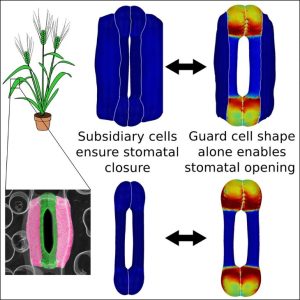 Stomata are pores on the surface of leaves essential for gas exchange. In grasses, stomatal aperture is controlled by pairs of dumbbell shaped guard cells, with each guard cell surrounded by a subsidiary cell. Despite cell geometry being well described, it was unclear how it influences stomata function. Here, Durney et al. used confocal imaging to visualize stomatal opening and stomatal closure in barley leaves. Using these data they derived a finite element model for barley stomata. They show that when subsidiary cell pressure was set to a constant value, no matter whether high or low, the stomata still functioned. However, removing subsidiary cells from the model prevented complete stomatal closure, showing the importance of subsidiary cells in this process. They experimentally tested this by imaging stomata from the Brachypodium distachyon bdmute mutant, which lacks subsidiary cells, and deriving additional mathematical models. The authors also used the mathematical models to investigate cell wall anisotropy in barley guard cells. When anisotropy was set at an orthogonal angle or removed completely, the stomata had normal pressure-aperture response curves, suggesting that guard cell anisotropy is not important for stomatal function. Therefore, this study dissects the role of cell geometry in grass stomatal function and emphasizes the power of combining computational and wet lab techniques. (Summary by Rose McNelly @Rose_McN) Curr. Biol. 10.1016/j.cub.2023.05.051
Stomata are pores on the surface of leaves essential for gas exchange. In grasses, stomatal aperture is controlled by pairs of dumbbell shaped guard cells, with each guard cell surrounded by a subsidiary cell. Despite cell geometry being well described, it was unclear how it influences stomata function. Here, Durney et al. used confocal imaging to visualize stomatal opening and stomatal closure in barley leaves. Using these data they derived a finite element model for barley stomata. They show that when subsidiary cell pressure was set to a constant value, no matter whether high or low, the stomata still functioned. However, removing subsidiary cells from the model prevented complete stomatal closure, showing the importance of subsidiary cells in this process. They experimentally tested this by imaging stomata from the Brachypodium distachyon bdmute mutant, which lacks subsidiary cells, and deriving additional mathematical models. The authors also used the mathematical models to investigate cell wall anisotropy in barley guard cells. When anisotropy was set at an orthogonal angle or removed completely, the stomata had normal pressure-aperture response curves, suggesting that guard cell anisotropy is not important for stomatal function. Therefore, this study dissects the role of cell geometry in grass stomatal function and emphasizes the power of combining computational and wet lab techniques. (Summary by Rose McNelly @Rose_McN) Curr. Biol. 10.1016/j.cub.2023.05.051
Interconnected: Hydrotropism and phototropism in Arabidopsis root growth
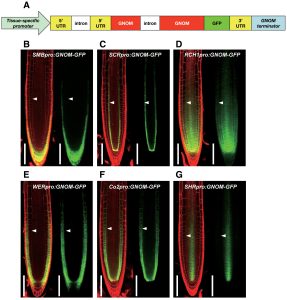 Tropisms enable plants to shift their growth direction in response to environmental changes. The roots of Arabidopsis plants respond to gravity by growing in the direction of gravity, a phenomenon known as gravitropism, while in response to unilateral blue light they bend away, demonstrating phototropism. Additionally, roots respond to moisture gradients by moving toward areas with greater water availability, resulting in hydrotropism. In this research article, Lei Pang and colleagues investigate the function of the proteins MIZ1 (MIZU-KUSSEI) and GNOM/MIZ2, which were previously isolated as ahydrotropic mutants, and attempt to determine their role in phototropic and hydrotropic responses of Arabidopsis roots. The study shows that MIZ1 has a role in recovering a complete phototropic response and hydrotropic response in Arabidopsis roots when expressed in the cortex of the elongation zone in miz1. The expression of GNOM in tissues- epidermis, cortex, or stele, is required for the full induction of these tropic responses in the roots. The function of MIZ1 and GNOM in the tissue elongation zone suggests a crosstalk between these tropisms. The discovery of MIZ1 and GNOM/MIZ2 as key actors in both hydrotropism and phototropism sheds light on how various environmental stimuli are coordinated during root growth. This study adds to our understanding of how plants use information from their surroundings to improve their growth and development. (Summary by Arpita Yadav arpita_yadav_). J. Exp. Bot. 10.1093/jxb/erad193
Tropisms enable plants to shift their growth direction in response to environmental changes. The roots of Arabidopsis plants respond to gravity by growing in the direction of gravity, a phenomenon known as gravitropism, while in response to unilateral blue light they bend away, demonstrating phototropism. Additionally, roots respond to moisture gradients by moving toward areas with greater water availability, resulting in hydrotropism. In this research article, Lei Pang and colleagues investigate the function of the proteins MIZ1 (MIZU-KUSSEI) and GNOM/MIZ2, which were previously isolated as ahydrotropic mutants, and attempt to determine their role in phototropic and hydrotropic responses of Arabidopsis roots. The study shows that MIZ1 has a role in recovering a complete phototropic response and hydrotropic response in Arabidopsis roots when expressed in the cortex of the elongation zone in miz1. The expression of GNOM in tissues- epidermis, cortex, or stele, is required for the full induction of these tropic responses in the roots. The function of MIZ1 and GNOM in the tissue elongation zone suggests a crosstalk between these tropisms. The discovery of MIZ1 and GNOM/MIZ2 as key actors in both hydrotropism and phototropism sheds light on how various environmental stimuli are coordinated during root growth. This study adds to our understanding of how plants use information from their surroundings to improve their growth and development. (Summary by Arpita Yadav arpita_yadav_). J. Exp. Bot. 10.1093/jxb/erad193
Hydrolyzable tannins are incorporated into the endocarp during sclerification of the water caltrop (Trapa natans)
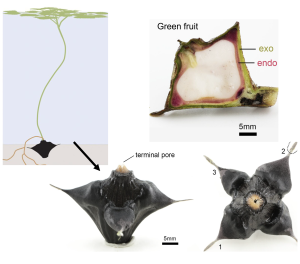 Trapa natans, also known as water caltrop or bat nut, is an aquatic plant with large seeds encased by a hardened endocarp. Due to this durable endocarp, these seeds may remain dormant underwater for up to 12 years. Huss et al. studied the anatomical and biochemical factors responsible for the hardened endocarp, focusing on the structural and compositional changes in the endocarp’s cell wall during fruit development. Histochemical staining and spectroscopy revealed chemical changes during cell wall thickening (sclerification) such as varying cellulose microfibril angles, which may contribute to mechanical reinforcement of the tissue. They also observed unbounded gallotannins (hydrolyzable tannins) which were formed in addition to lignin and cellulose during secondary wall formation. After maturation, the gallotannins become bounded to the cell wall via ester bonds and persist post maturation. Aside from the toughness and durability they confer on the cell wall, gallotannins in the endocarp are useful as defense to protect T. natans seeds against insect and microbial attacks. (Summary by Idowu Arinola Obisesan @IdowuAobisesan) Plant Physiol. 10.1093/plphys/kiad408
Trapa natans, also known as water caltrop or bat nut, is an aquatic plant with large seeds encased by a hardened endocarp. Due to this durable endocarp, these seeds may remain dormant underwater for up to 12 years. Huss et al. studied the anatomical and biochemical factors responsible for the hardened endocarp, focusing on the structural and compositional changes in the endocarp’s cell wall during fruit development. Histochemical staining and spectroscopy revealed chemical changes during cell wall thickening (sclerification) such as varying cellulose microfibril angles, which may contribute to mechanical reinforcement of the tissue. They also observed unbounded gallotannins (hydrolyzable tannins) which were formed in addition to lignin and cellulose during secondary wall formation. After maturation, the gallotannins become bounded to the cell wall via ester bonds and persist post maturation. Aside from the toughness and durability they confer on the cell wall, gallotannins in the endocarp are useful as defense to protect T. natans seeds against insect and microbial attacks. (Summary by Idowu Arinola Obisesan @IdowuAobisesan) Plant Physiol. 10.1093/plphys/kiad408
Comparison of red raspberry and wild strawberry fruits reveals mechanisms of fruit type specification
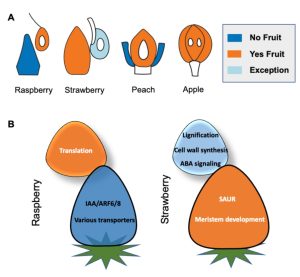 Here’s a sweet story of gene expression and fruit form, starting with the simple question of “why do closely related strawberry and raspberry fruits look so different?” In strawberry, the ovaries become dry achenes where in raspberies they become juicy druplets; in strawberry the stem tip (receptacle) becomes the juicy fruit, where in raspberry it shrinks and dries. To investigate the molecular bases for these different tissue fates, Zhou et al. carried out genomic and transcriptomic analysis of red raspberry (Rubus idaeus), which they compared to datasets from wild strawberry (Fragaria vesca). Through this, they identified sets of genes in each organ type that are differentially expressed between fruit types, providing a framework for understanding the evolution of different fruit types. (This article reminds me of one of my favorite episodes of Dr. Molly Edward’s YouTube series, Science IRL, in which she describes all the different ways that plants produce fruits https://youtu.be/a6nKRTG-L4k). (Summary by Mary Williams @PlantTeaching) Plant Physiol. 10.1093/plphys/kiad409
Here’s a sweet story of gene expression and fruit form, starting with the simple question of “why do closely related strawberry and raspberry fruits look so different?” In strawberry, the ovaries become dry achenes where in raspberies they become juicy druplets; in strawberry the stem tip (receptacle) becomes the juicy fruit, where in raspberry it shrinks and dries. To investigate the molecular bases for these different tissue fates, Zhou et al. carried out genomic and transcriptomic analysis of red raspberry (Rubus idaeus), which they compared to datasets from wild strawberry (Fragaria vesca). Through this, they identified sets of genes in each organ type that are differentially expressed between fruit types, providing a framework for understanding the evolution of different fruit types. (This article reminds me of one of my favorite episodes of Dr. Molly Edward’s YouTube series, Science IRL, in which she describes all the different ways that plants produce fruits https://youtu.be/a6nKRTG-L4k). (Summary by Mary Williams @PlantTeaching) Plant Physiol. 10.1093/plphys/kiad409
Root- knot nematodes produce functional mimics of tyrosine-sulfated plant peptides
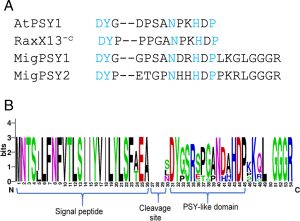 I love reading about pathogens hijacking host systems; I’m always thrilled to see how “life finds a way”. Here’s another. Plants use a variety of peptides as hormones, many of which have covalent modifications of one sort or another. One class are the tyrosine-sulfated peptides, the PLANT PEPTIDE CONTAINING SULFATED TYROSINE (PSY)-family. PSY family peptides suppress defense signaling and promote root development, and previously it has been shown that a Xanthomanas bacterial pathogen of plants can produce functional PSY mimics. Here, Yimer et al. show that root-knot nematodes also carry genes encoding PSY-like peptides. Application of the peptides in the absence of the nematodes promotes root growth. Furthermore, a siRNA approach to downregulate expression of the genes in the nematodes suppressed both root galling and egg production, suggesting a potential avenue to promote plant resistance against parasitic nematodes. (Summary by Mary Williams @PlantTeaching) Proc. Natl. Acad. Sci. USA 10.1073/pnas.2304612120
I love reading about pathogens hijacking host systems; I’m always thrilled to see how “life finds a way”. Here’s another. Plants use a variety of peptides as hormones, many of which have covalent modifications of one sort or another. One class are the tyrosine-sulfated peptides, the PLANT PEPTIDE CONTAINING SULFATED TYROSINE (PSY)-family. PSY family peptides suppress defense signaling and promote root development, and previously it has been shown that a Xanthomanas bacterial pathogen of plants can produce functional PSY mimics. Here, Yimer et al. show that root-knot nematodes also carry genes encoding PSY-like peptides. Application of the peptides in the absence of the nematodes promotes root growth. Furthermore, a siRNA approach to downregulate expression of the genes in the nematodes suppressed both root galling and egg production, suggesting a potential avenue to promote plant resistance against parasitic nematodes. (Summary by Mary Williams @PlantTeaching) Proc. Natl. Acad. Sci. USA 10.1073/pnas.2304612120
Putting a stop to misogyny in the scientific community
 The pervasive issue with misogyny in the scientific community has drawn more attention as people and organizations work to promote equality and inclusivity. The importance of confronting and eliminating gender-based discrimination within scientific disciplines is discussed in this article by Alison Bentley and Rachael Garrett. Women facing challenges in science such as systematic biases, gender stereotypes, and unfriendly work situations cannot be ignored. Scientific progress is contingent upon embracing diversity and providing equal opportunities to all scientists. In addition to affecting women’s domestic and professional lives, misogyny impedes scientific progress by eliminating their valuable contributions. The article advocates for a diversified strategy to address misogyny in science. It emphasizes the significance of creating awareness and cultivating a culture of respect, equality, and inclusion. Promoting mentorship programs, offering support networks, and putting regulations in place to address and prevent gender-based discrimination are all critical steps toward establishing a fair scientific community. The fight against misogyny in science necessitates group efforts, with individuals, organizations, and society at large cooperating to build a just and inclusive scientific community. Science may flourish and gain from the many viewpoints and skills of all scientists if gender equality is prioritized, and discriminatory practices are fought. (Summary by Arpita Yadav arpita_yadav_). Nature https://doi.org/10.1038/d41586-023-02101-x
The pervasive issue with misogyny in the scientific community has drawn more attention as people and organizations work to promote equality and inclusivity. The importance of confronting and eliminating gender-based discrimination within scientific disciplines is discussed in this article by Alison Bentley and Rachael Garrett. Women facing challenges in science such as systematic biases, gender stereotypes, and unfriendly work situations cannot be ignored. Scientific progress is contingent upon embracing diversity and providing equal opportunities to all scientists. In addition to affecting women’s domestic and professional lives, misogyny impedes scientific progress by eliminating their valuable contributions. The article advocates for a diversified strategy to address misogyny in science. It emphasizes the significance of creating awareness and cultivating a culture of respect, equality, and inclusion. Promoting mentorship programs, offering support networks, and putting regulations in place to address and prevent gender-based discrimination are all critical steps toward establishing a fair scientific community. The fight against misogyny in science necessitates group efforts, with individuals, organizations, and society at large cooperating to build a just and inclusive scientific community. Science may flourish and gain from the many viewpoints and skills of all scientists if gender equality is prioritized, and discriminatory practices are fought. (Summary by Arpita Yadav arpita_yadav_). Nature https://doi.org/10.1038/d41586-023-02101-x


